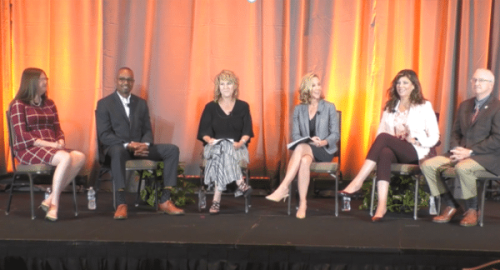The 2021 State of School Safety Report, developed by Safe and Sound Schools and Raptor Technologies, revealed how staff, administrators, students, and guardians feel about school safety. The report identified numerous areas where students and guardians feel less confident than administrators in the school’s ability to keep everyone safe.
In a live panel discussion, a group of K-12 safety experts discussed the key findings and what schools should consider as they reopen this fall. Continue reading for a summary of their discussion. You can watch the full panel here.
SROs Are Part of the Overall Safety Team
Despite the conversations questioning school resource officers (SROs) in schools, an overwhelming majority of school administrators (nearly 100%) and parents (over 75%) think SROs are valuable resources to keep students safe.
Some schools ask if they should replace school resource officers (SROs) with other resources, such as mental health professionals, but experts agree that it’s not one versus the other. “I am an advocate for any type of mental health assistance we can get in [the school] environment,” Mo Canady, Executive Director for the National Association of School Resource Officers (NASRO), says. As a former SRO with over 25 years of experience in law enforcement, Mo collaborated with social workers, counselors, nurses, administrators, and anyone else who was responsible for school safety. “Everyone has a role to play,” he continues.
Michele Gay, co-founder of Safe and Sound Schools, agrees, “We all have something special to bring to this goal of keeping every school—every child—safe and sound. Our team is not complete if there is one person missing or if somebody has been removed from the equation.”
“There is this social pressure right now that really frightens me, both as a parent and a 28-year police veteran,” Susan Payne, Founder and Former Executive Director of Safe2Tell, shares about her concern of schools removing SROs. Schools can put themselves at risk when they only focus on this pressure.
It’s critical that the school safety team has people from various disciplines and backgrounds. This helps ensure the school builds comprehensive, well-rounded policies and procedures based on research and expertise from various stakeholders.
Parents Need and Appreciate Open Communication
While nearly 70% of school administrators think their school has a strong sense of security, the survey found that half of parents feel that their child’s school has a false sense of security.
Retired Chief of the Miami-Dade Schools Police Department, Ian A. Moffett, reminds school leaders that parents may understand the mandates schools must follow—how many lockdown drills should be conducted each year for example—but they want to know more about the policies and procedures behind those requirements. “We have to do a much better job at publicizing what’s mandated, how we [comply with those mandates], and why we do what we do,” he concludes.
“It’s the fear of the unknown that makes parents anxious,” Donna Michaelis, Director of the Virginia Center for School and Campus Safety, adds. If schools are not communicating, parents may start having negative perceptions and become anxious, especially when they hear about worrisome events in the news. School leaders and administrators should build personal relationships with students and guardians. Schools should also leverage online communication via its website and social media to share information with their community, as not every parent is going to be involved in the PTA or attend Open House events.
Communication is about empowering the community to discuss their concerns with the school, but some students and guardians are hesitant to share feedback directly with school leaders and administrators. Elizabeth Brown, principal of Forest High School in Ocala, Florida, has an advisory board to act as the liaison between her and her community members. The board listens to the concerns and shares the intel with Elizabeth so that she can take appropriate action and improve her safety plans based on the feedback.
The Entire School Needs to Know the Safety Policies
Recalling the day her daughter died in the Sandy Hook tragedy, Michele shares, “There was a substitute in my daughter’s classroom that day… She did not have training. She did not have a manual; she did not have a key to lock the door. We need to think about everyone and how well we’re equipping them…how well we are giving them what they need to keep themselves safe and everyone around them safe.”
This requires involving everyone in drills so that the entire school knows what to do in an actual emergency. This includes collaborating with first responders, parents, and other appropriate community members. When there is an emergency, these groups will be just as involved in the response as school staff, teachers, and students. Parents, for example, need to know reunification plans, but the survey shows an alarming 50% of parents do not know what to do to be safely reunited with their child(ren) after an incident.
School leaders should also teach staff and students how to recognize potential safety threats and who to notify if they are concerned about something they have seen or heard. “No matter what open door policy you have, the young people are our eyes and ears,” Susan reminds us. “We have to do a better job at teaching students and staff what they can do to prevent crises.”
Stay Updated with the Latest Guidance
For more recommendations and to stay updated on the latest school safety news, subscribe to Raptor’s podcast, School Safety Today, or contact us to learn how Raptor can help you build and maintain a safer school.





